Management Accounting Report: Tesco's Financial Analysis
VerifiedAdded on 2023/01/12
|16
|3857
|26
Report
AI Summary
This report provides a comprehensive analysis of management accounting principles and their application within the context of Tesco, a large British retailer. The report begins with an introduction to management accounting, differentiating it from financial accounting and highlighting its role in internal decision-making. It then delves into the specific requirements and systems of management accounting, including inventory management, price optimization, and cost accounting systems, with examples of how Tesco utilizes these systems. The main body further explores methods of management accounting reporting, such as inventory management reports, accounts receivable aging reports, performance reports, and cost accounting reports. The report also includes a practical application, calculating costs using marginal and absorption costing to create an income statement. Finally, it discusses the advantages and disadvantages of various planning tools used for budgetary control within Tesco, such as capital budgeting, and concludes with an evaluation of how Tesco adapts its management accounting system to respond to financial challenges.
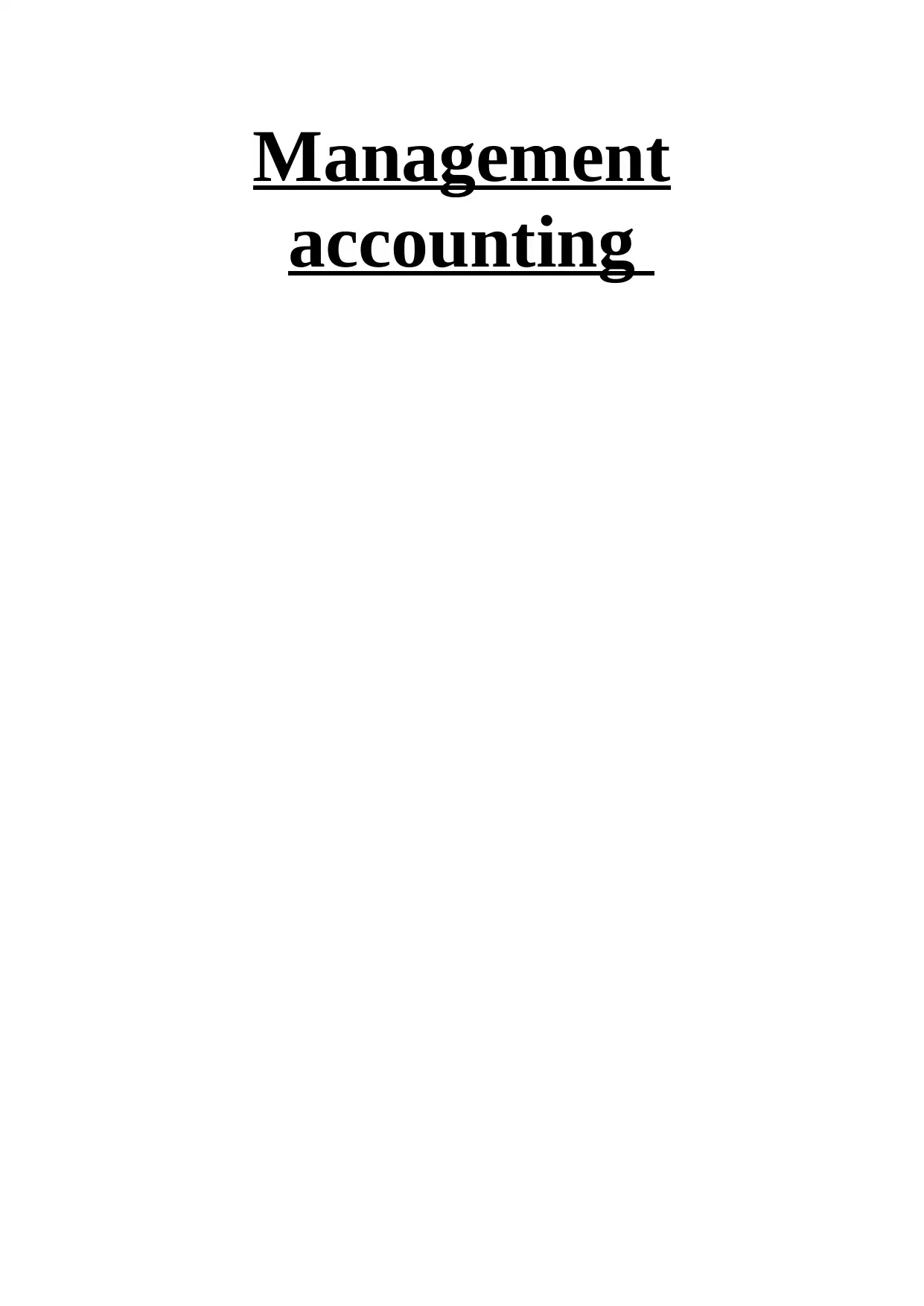
Management
accounting
accounting
Paraphrase This Document
Need a fresh take? Get an instant paraphrase of this document with our AI Paraphraser
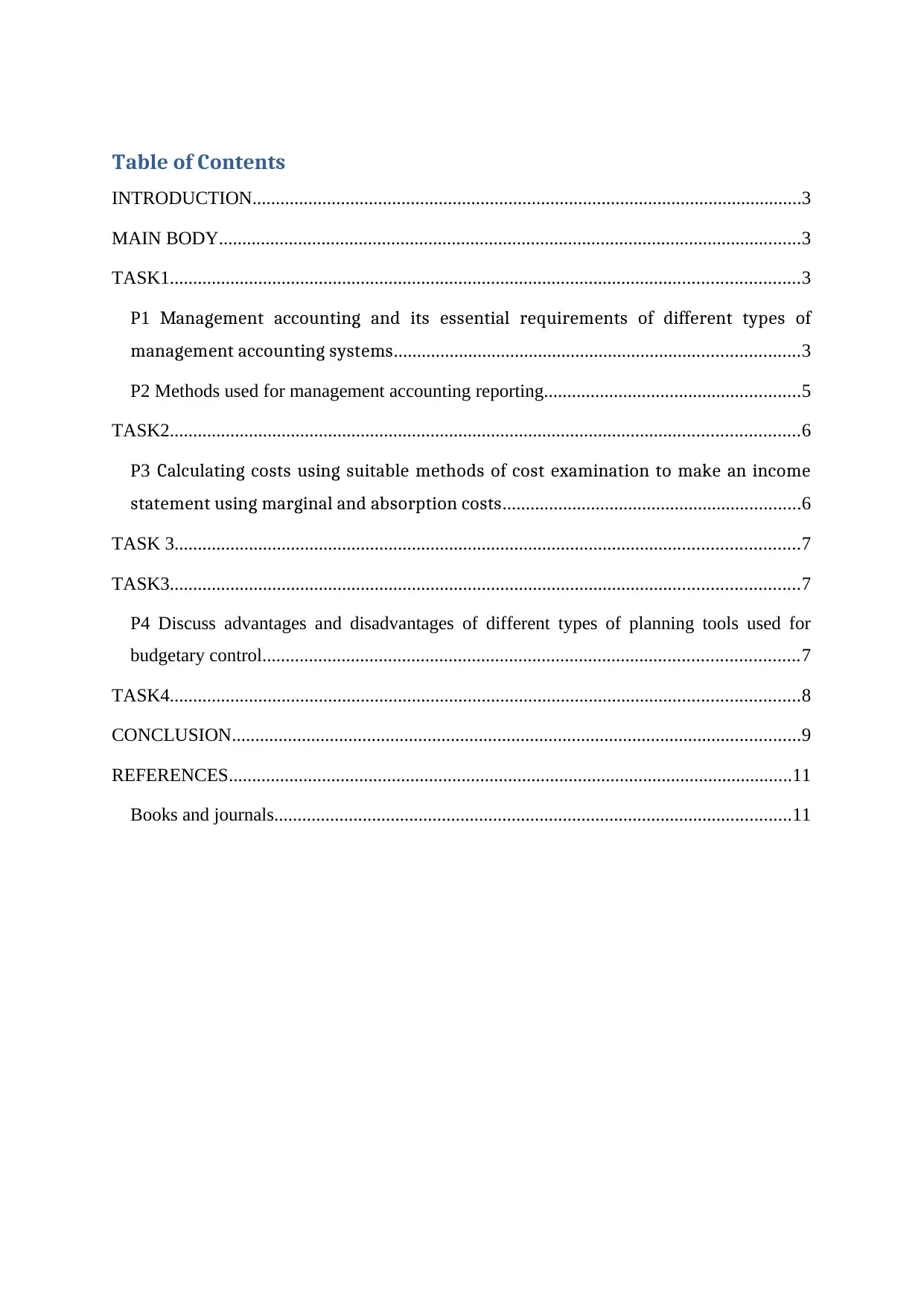
Table of Contents
INTRODUCTION......................................................................................................................3
MAIN BODY.............................................................................................................................3
TASK1.......................................................................................................................................3
P1 Management accounting and its essential requirements of different types of
management accounting systems.......................................................................................3
P2 Methods used for management accounting reporting.......................................................5
TASK2.......................................................................................................................................6
P3 Calculating costs using suitable methods of cost examination to make an income
statement using marginal and absorption costs................................................................6
TASK 3......................................................................................................................................7
TASK3.......................................................................................................................................7
P4 Discuss advantages and disadvantages of different types of planning tools used for
budgetary control...................................................................................................................7
TASK4.......................................................................................................................................8
CONCLUSION..........................................................................................................................9
REFERENCES.........................................................................................................................11
Books and journals...............................................................................................................11
INTRODUCTION......................................................................................................................3
MAIN BODY.............................................................................................................................3
TASK1.......................................................................................................................................3
P1 Management accounting and its essential requirements of different types of
management accounting systems.......................................................................................3
P2 Methods used for management accounting reporting.......................................................5
TASK2.......................................................................................................................................6
P3 Calculating costs using suitable methods of cost examination to make an income
statement using marginal and absorption costs................................................................6
TASK 3......................................................................................................................................7
TASK3.......................................................................................................................................7
P4 Discuss advantages and disadvantages of different types of planning tools used for
budgetary control...................................................................................................................7
TASK4.......................................................................................................................................8
CONCLUSION..........................................................................................................................9
REFERENCES.........................................................................................................................11
Books and journals...............................................................................................................11
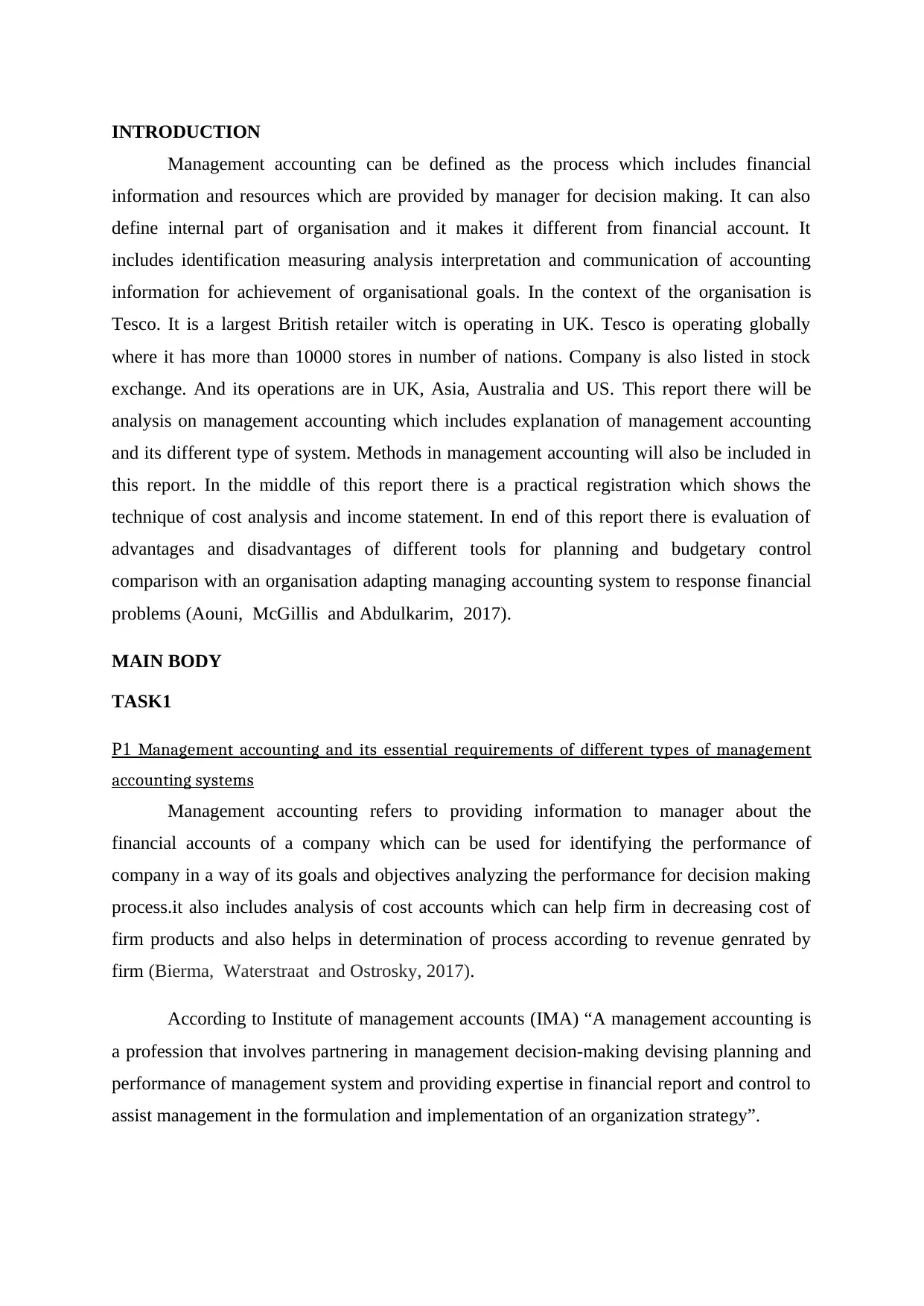
INTRODUCTION
Management accounting can be defined as the process which includes financial
information and resources which are provided by manager for decision making. It can also
define internal part of organisation and it makes it different from financial account. It
includes identification measuring analysis interpretation and communication of accounting
information for achievement of organisational goals. In the context of the organisation is
Tesco. It is a largest British retailer witch is operating in UK. Tesco is operating globally
where it has more than 10000 stores in number of nations. Company is also listed in stock
exchange. And its operations are in UK, Asia, Australia and US. This report there will be
analysis on management accounting which includes explanation of management accounting
and its different type of system. Methods in management accounting will also be included in
this report. In the middle of this report there is a practical registration which shows the
technique of cost analysis and income statement. In end of this report there is evaluation of
advantages and disadvantages of different tools for planning and budgetary control
comparison with an organisation adapting managing accounting system to response financial
problems (Aouni, McGillis and Abdulkarim, 2017).
MAIN BODY
TASK1
P1 Management accounting and its essential requirements of different types of management
accounting systems
Management accounting refers to providing information to manager about the
financial accounts of a company which can be used for identifying the performance of
company in a way of its goals and objectives analyzing the performance for decision making
process.it also includes analysis of cost accounts which can help firm in decreasing cost of
firm products and also helps in determination of process according to revenue genrated by
firm (Bierma, Waterstraat and Ostrosky, 2017).
According to Institute of management accounts (IMA) “A management accounting is
a profession that involves partnering in management decision-making devising planning and
performance of management system and providing expertise in financial report and control to
assist management in the formulation and implementation of an organization strategy”.
Management accounting can be defined as the process which includes financial
information and resources which are provided by manager for decision making. It can also
define internal part of organisation and it makes it different from financial account. It
includes identification measuring analysis interpretation and communication of accounting
information for achievement of organisational goals. In the context of the organisation is
Tesco. It is a largest British retailer witch is operating in UK. Tesco is operating globally
where it has more than 10000 stores in number of nations. Company is also listed in stock
exchange. And its operations are in UK, Asia, Australia and US. This report there will be
analysis on management accounting which includes explanation of management accounting
and its different type of system. Methods in management accounting will also be included in
this report. In the middle of this report there is a practical registration which shows the
technique of cost analysis and income statement. In end of this report there is evaluation of
advantages and disadvantages of different tools for planning and budgetary control
comparison with an organisation adapting managing accounting system to response financial
problems (Aouni, McGillis and Abdulkarim, 2017).
MAIN BODY
TASK1
P1 Management accounting and its essential requirements of different types of management
accounting systems
Management accounting refers to providing information to manager about the
financial accounts of a company which can be used for identifying the performance of
company in a way of its goals and objectives analyzing the performance for decision making
process.it also includes analysis of cost accounts which can help firm in decreasing cost of
firm products and also helps in determination of process according to revenue genrated by
firm (Bierma, Waterstraat and Ostrosky, 2017).
According to Institute of management accounts (IMA) “A management accounting is
a profession that involves partnering in management decision-making devising planning and
performance of management system and providing expertise in financial report and control to
assist management in the formulation and implementation of an organization strategy”.
⊘ This is a preview!⊘
Do you want full access?
Subscribe today to unlock all pages.

Trusted by 1+ million students worldwide
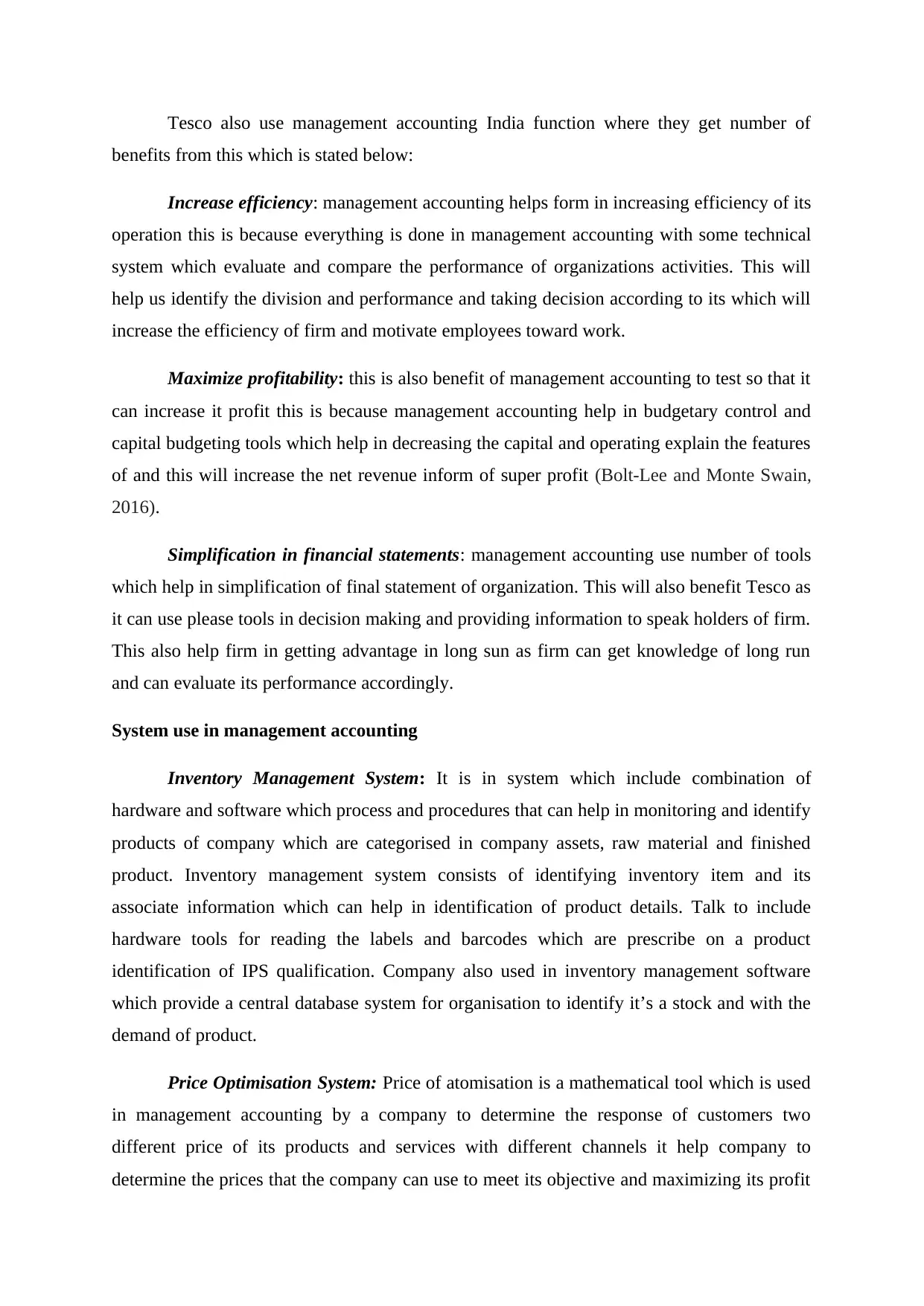
Tesco also use management accounting India function where they get number of
benefits from this which is stated below:
Increase efficiency: management accounting helps form in increasing efficiency of its
operation this is because everything is done in management accounting with some technical
system which evaluate and compare the performance of organizations activities. This will
help us identify the division and performance and taking decision according to its which will
increase the efficiency of firm and motivate employees toward work.
Maximize profitability: this is also benefit of management accounting to test so that it
can increase it profit this is because management accounting help in budgetary control and
capital budgeting tools which help in decreasing the capital and operating explain the features
of and this will increase the net revenue inform of super profit (Bolt-Lee and Monte Swain,
2016).
Simplification in financial statements: management accounting use number of tools
which help in simplification of final statement of organization. This will also benefit Tesco as
it can use please tools in decision making and providing information to speak holders of firm.
This also help firm in getting advantage in long sun as firm can get knowledge of long run
and can evaluate its performance accordingly.
System use in management accounting
Inventory Management System: It is in system which include combination of
hardware and software which process and procedures that can help in monitoring and identify
products of company which are categorised in company assets, raw material and finished
product. Inventory management system consists of identifying inventory item and its
associate information which can help in identification of product details. Talk to include
hardware tools for reading the labels and barcodes which are prescribe on a product
identification of IPS qualification. Company also used in inventory management software
which provide a central database system for organisation to identify it’s a stock and with the
demand of product.
Price Optimisation System: Price of atomisation is a mathematical tool which is used
in management accounting by a company to determine the response of customers two
different price of its products and services with different channels it help company to
determine the prices that the company can use to meet its objective and maximizing its profit
benefits from this which is stated below:
Increase efficiency: management accounting helps form in increasing efficiency of its
operation this is because everything is done in management accounting with some technical
system which evaluate and compare the performance of organizations activities. This will
help us identify the division and performance and taking decision according to its which will
increase the efficiency of firm and motivate employees toward work.
Maximize profitability: this is also benefit of management accounting to test so that it
can increase it profit this is because management accounting help in budgetary control and
capital budgeting tools which help in decreasing the capital and operating explain the features
of and this will increase the net revenue inform of super profit (Bolt-Lee and Monte Swain,
2016).
Simplification in financial statements: management accounting use number of tools
which help in simplification of final statement of organization. This will also benefit Tesco as
it can use please tools in decision making and providing information to speak holders of firm.
This also help firm in getting advantage in long sun as firm can get knowledge of long run
and can evaluate its performance accordingly.
System use in management accounting
Inventory Management System: It is in system which include combination of
hardware and software which process and procedures that can help in monitoring and identify
products of company which are categorised in company assets, raw material and finished
product. Inventory management system consists of identifying inventory item and its
associate information which can help in identification of product details. Talk to include
hardware tools for reading the labels and barcodes which are prescribe on a product
identification of IPS qualification. Company also used in inventory management software
which provide a central database system for organisation to identify it’s a stock and with the
demand of product.
Price Optimisation System: Price of atomisation is a mathematical tool which is used
in management accounting by a company to determine the response of customers two
different price of its products and services with different channels it help company to
determine the prices that the company can use to meet its objective and maximizing its profit
Paraphrase This Document
Need a fresh take? Get an instant paraphrase of this document with our AI Paraphraser
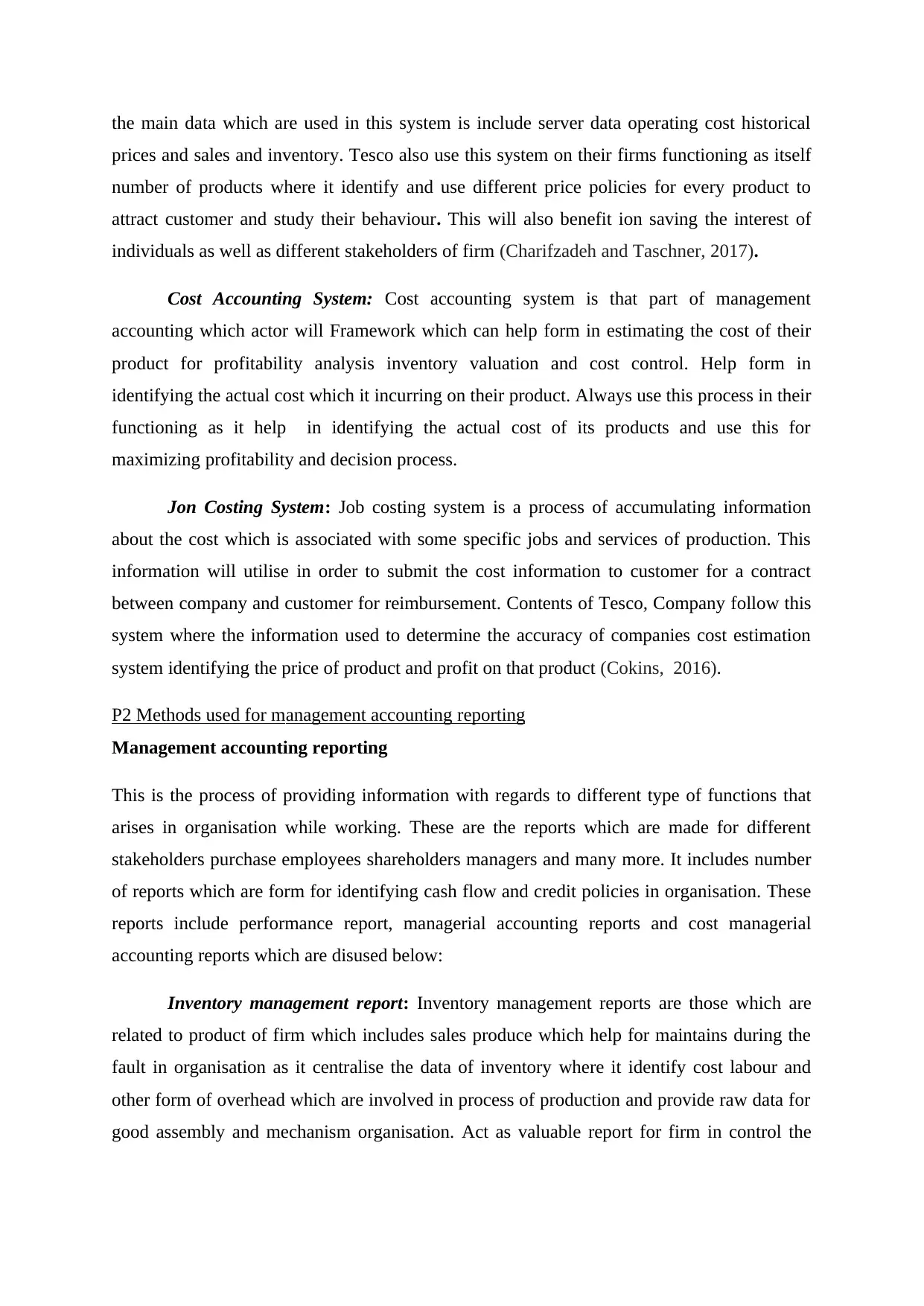
the main data which are used in this system is include server data operating cost historical
prices and sales and inventory. Tesco also use this system on their firms functioning as itself
number of products where it identify and use different price policies for every product to
attract customer and study their behaviour. This will also benefit ion saving the interest of
individuals as well as different stakeholders of firm (Charifzadeh and Taschner, 2017).
Cost Accounting System: Cost accounting system is that part of management
accounting which actor will Framework which can help form in estimating the cost of their
product for profitability analysis inventory valuation and cost control. Help form in
identifying the actual cost which it incurring on their product. Always use this process in their
functioning as it help in identifying the actual cost of its products and use this for
maximizing profitability and decision process.
Jon Costing System: Job costing system is a process of accumulating information
about the cost which is associated with some specific jobs and services of production. This
information will utilise in order to submit the cost information to customer for a contract
between company and customer for reimbursement. Contents of Tesco, Company follow this
system where the information used to determine the accuracy of companies cost estimation
system identifying the price of product and profit on that product (Cokins, 2016).
P2 Methods used for management accounting reporting
Management accounting reporting
This is the process of providing information with regards to different type of functions that
arises in organisation while working. These are the reports which are made for different
stakeholders purchase employees shareholders managers and many more. It includes number
of reports which are form for identifying cash flow and credit policies in organisation. These
reports include performance report, managerial accounting reports and cost managerial
accounting reports which are disused below:
Inventory management report: Inventory management reports are those which are
related to product of firm which includes sales produce which help for maintains during the
fault in organisation as it centralise the data of inventory where it identify cost labour and
other form of overhead which are involved in process of production and provide raw data for
good assembly and mechanism organisation. Act as valuable report for firm in control the
prices and sales and inventory. Tesco also use this system on their firms functioning as itself
number of products where it identify and use different price policies for every product to
attract customer and study their behaviour. This will also benefit ion saving the interest of
individuals as well as different stakeholders of firm (Charifzadeh and Taschner, 2017).
Cost Accounting System: Cost accounting system is that part of management
accounting which actor will Framework which can help form in estimating the cost of their
product for profitability analysis inventory valuation and cost control. Help form in
identifying the actual cost which it incurring on their product. Always use this process in their
functioning as it help in identifying the actual cost of its products and use this for
maximizing profitability and decision process.
Jon Costing System: Job costing system is a process of accumulating information
about the cost which is associated with some specific jobs and services of production. This
information will utilise in order to submit the cost information to customer for a contract
between company and customer for reimbursement. Contents of Tesco, Company follow this
system where the information used to determine the accuracy of companies cost estimation
system identifying the price of product and profit on that product (Cokins, 2016).
P2 Methods used for management accounting reporting
Management accounting reporting
This is the process of providing information with regards to different type of functions that
arises in organisation while working. These are the reports which are made for different
stakeholders purchase employees shareholders managers and many more. It includes number
of reports which are form for identifying cash flow and credit policies in organisation. These
reports include performance report, managerial accounting reports and cost managerial
accounting reports which are disused below:
Inventory management report: Inventory management reports are those which are
related to product of firm which includes sales produce which help for maintains during the
fault in organisation as it centralise the data of inventory where it identify cost labour and
other form of overhead which are involved in process of production and provide raw data for
good assembly and mechanism organisation. Act as valuable report for firm in control the
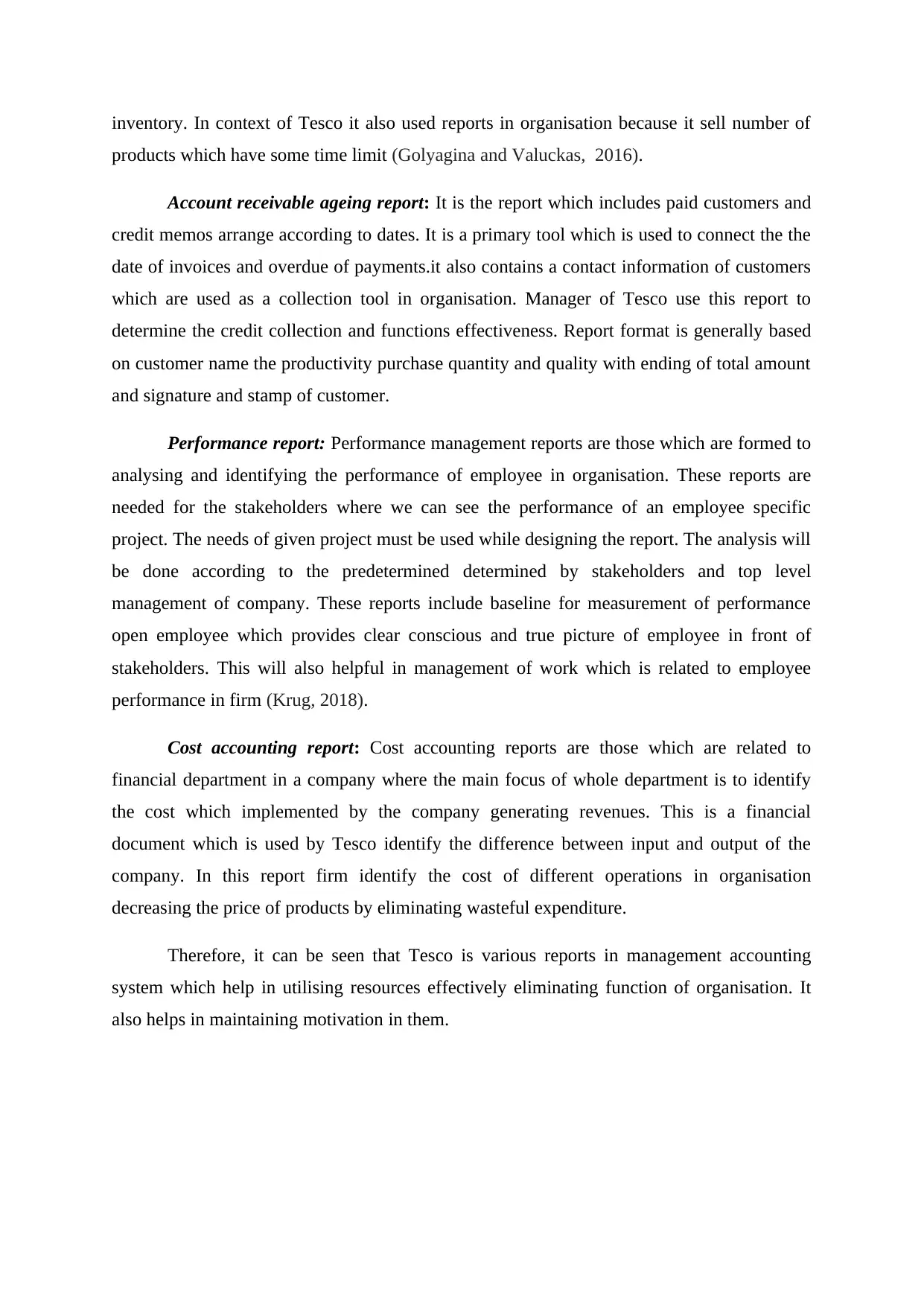
inventory. In context of Tesco it also used reports in organisation because it sell number of
products which have some time limit (Golyagina and Valuckas, 2016).
Account receivable ageing report: It is the report which includes paid customers and
credit memos arrange according to dates. It is a primary tool which is used to connect the the
date of invoices and overdue of payments.it also contains a contact information of customers
which are used as a collection tool in organisation. Manager of Tesco use this report to
determine the credit collection and functions effectiveness. Report format is generally based
on customer name the productivity purchase quantity and quality with ending of total amount
and signature and stamp of customer.
Performance report: Performance management reports are those which are formed to
analysing and identifying the performance of employee in organisation. These reports are
needed for the stakeholders where we can see the performance of an employee specific
project. The needs of given project must be used while designing the report. The analysis will
be done according to the predetermined determined by stakeholders and top level
management of company. These reports include baseline for measurement of performance
open employee which provides clear conscious and true picture of employee in front of
stakeholders. This will also helpful in management of work which is related to employee
performance in firm (Krug, 2018).
Cost accounting report: Cost accounting reports are those which are related to
financial department in a company where the main focus of whole department is to identify
the cost which implemented by the company generating revenues. This is a financial
document which is used by Tesco identify the difference between input and output of the
company. In this report firm identify the cost of different operations in organisation
decreasing the price of products by eliminating wasteful expenditure.
Therefore, it can be seen that Tesco is various reports in management accounting
system which help in utilising resources effectively eliminating function of organisation. It
also helps in maintaining motivation in them.
products which have some time limit (Golyagina and Valuckas, 2016).
Account receivable ageing report: It is the report which includes paid customers and
credit memos arrange according to dates. It is a primary tool which is used to connect the the
date of invoices and overdue of payments.it also contains a contact information of customers
which are used as a collection tool in organisation. Manager of Tesco use this report to
determine the credit collection and functions effectiveness. Report format is generally based
on customer name the productivity purchase quantity and quality with ending of total amount
and signature and stamp of customer.
Performance report: Performance management reports are those which are formed to
analysing and identifying the performance of employee in organisation. These reports are
needed for the stakeholders where we can see the performance of an employee specific
project. The needs of given project must be used while designing the report. The analysis will
be done according to the predetermined determined by stakeholders and top level
management of company. These reports include baseline for measurement of performance
open employee which provides clear conscious and true picture of employee in front of
stakeholders. This will also helpful in management of work which is related to employee
performance in firm (Krug, 2018).
Cost accounting report: Cost accounting reports are those which are related to
financial department in a company where the main focus of whole department is to identify
the cost which implemented by the company generating revenues. This is a financial
document which is used by Tesco identify the difference between input and output of the
company. In this report firm identify the cost of different operations in organisation
decreasing the price of products by eliminating wasteful expenditure.
Therefore, it can be seen that Tesco is various reports in management accounting
system which help in utilising resources effectively eliminating function of organisation. It
also helps in maintaining motivation in them.
⊘ This is a preview!⊘
Do you want full access?
Subscribe today to unlock all pages.

Trusted by 1+ million students worldwide
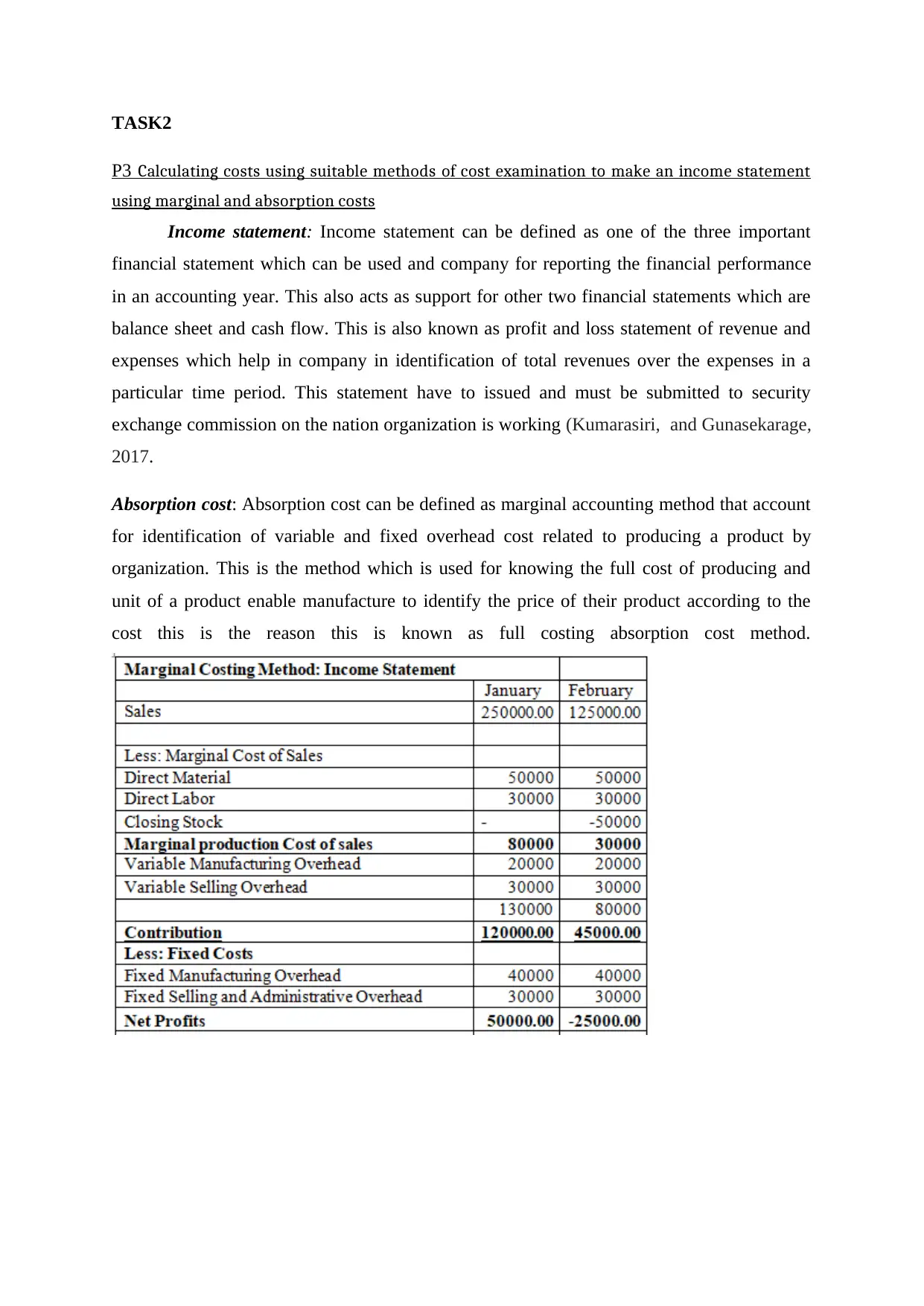
TASK2
P3 Calculating costs using suitable methods of cost examination to make an income statement
using marginal and absorption costs
Income statement: Income statement can be defined as one of the three important
financial statement which can be used and company for reporting the financial performance
in an accounting year. This also acts as support for other two financial statements which are
balance sheet and cash flow. This is also known as profit and loss statement of revenue and
expenses which help in company in identification of total revenues over the expenses in a
particular time period. This statement have to issued and must be submitted to security
exchange commission on the nation organization is working (Kumarasiri, and Gunasekarage,
2017.
Absorption cost: Absorption cost can be defined as marginal accounting method that account
for identification of variable and fixed overhead cost related to producing a product by
organization. This is the method which is used for knowing the full cost of producing and
unit of a product enable manufacture to identify the price of their product according to the
cost this is the reason this is known as full costing absorption cost method.
P3 Calculating costs using suitable methods of cost examination to make an income statement
using marginal and absorption costs
Income statement: Income statement can be defined as one of the three important
financial statement which can be used and company for reporting the financial performance
in an accounting year. This also acts as support for other two financial statements which are
balance sheet and cash flow. This is also known as profit and loss statement of revenue and
expenses which help in company in identification of total revenues over the expenses in a
particular time period. This statement have to issued and must be submitted to security
exchange commission on the nation organization is working (Kumarasiri, and Gunasekarage,
2017.
Absorption cost: Absorption cost can be defined as marginal accounting method that account
for identification of variable and fixed overhead cost related to producing a product by
organization. This is the method which is used for knowing the full cost of producing and
unit of a product enable manufacture to identify the price of their product according to the
cost this is the reason this is known as full costing absorption cost method.
Paraphrase This Document
Need a fresh take? Get an instant paraphrase of this document with our AI Paraphraser
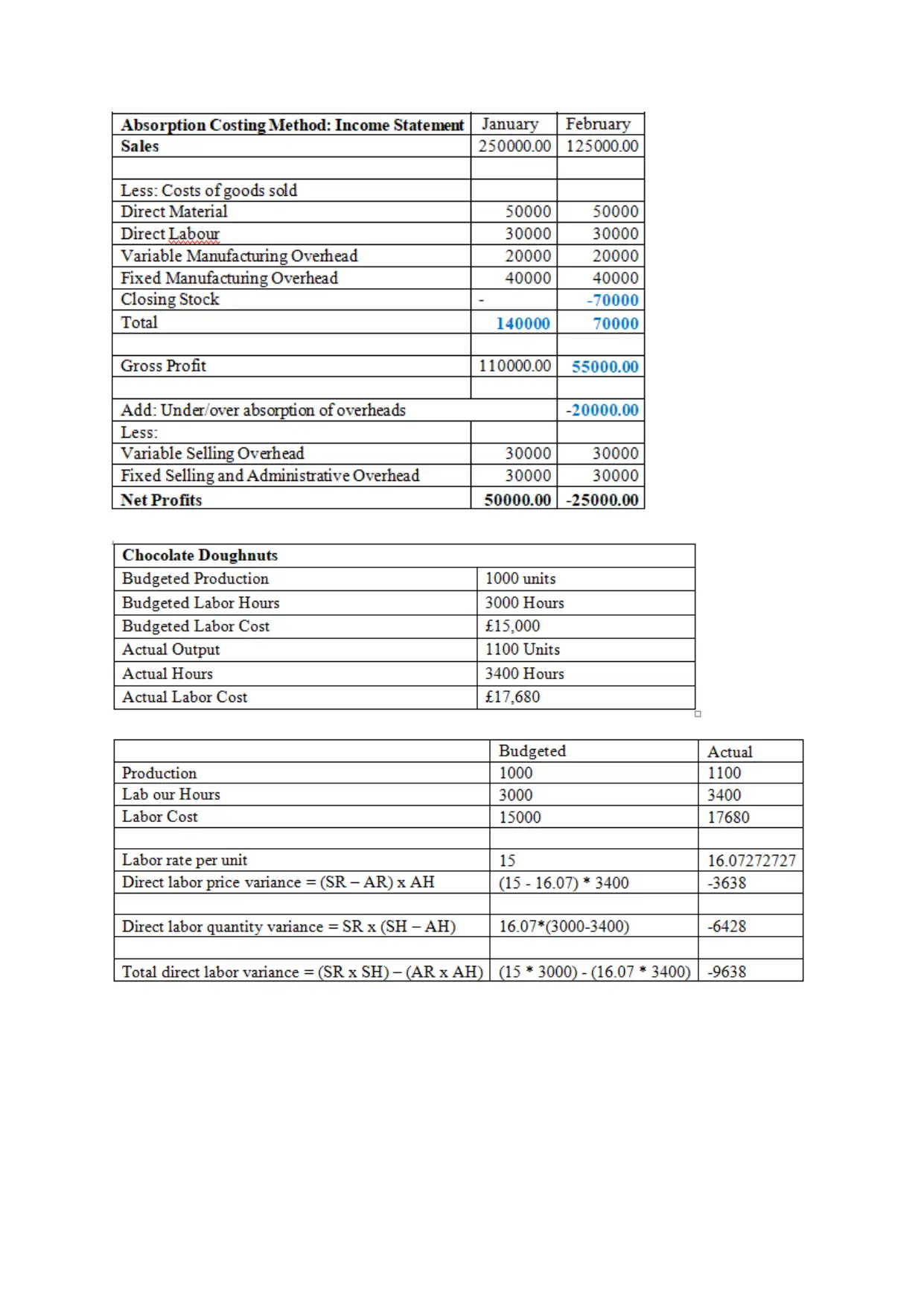
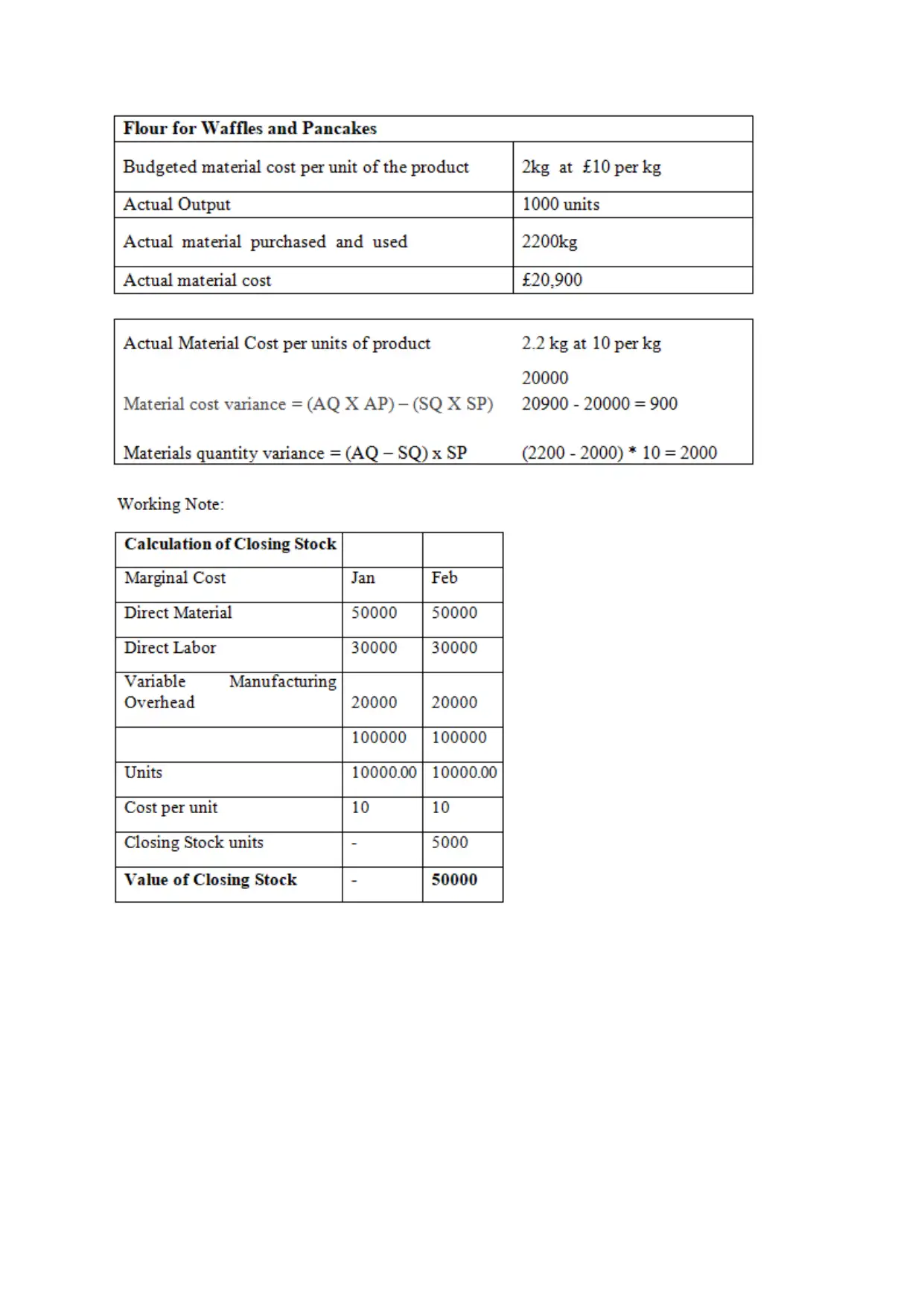
⊘ This is a preview!⊘
Do you want full access?
Subscribe today to unlock all pages.

Trusted by 1+ million students worldwide
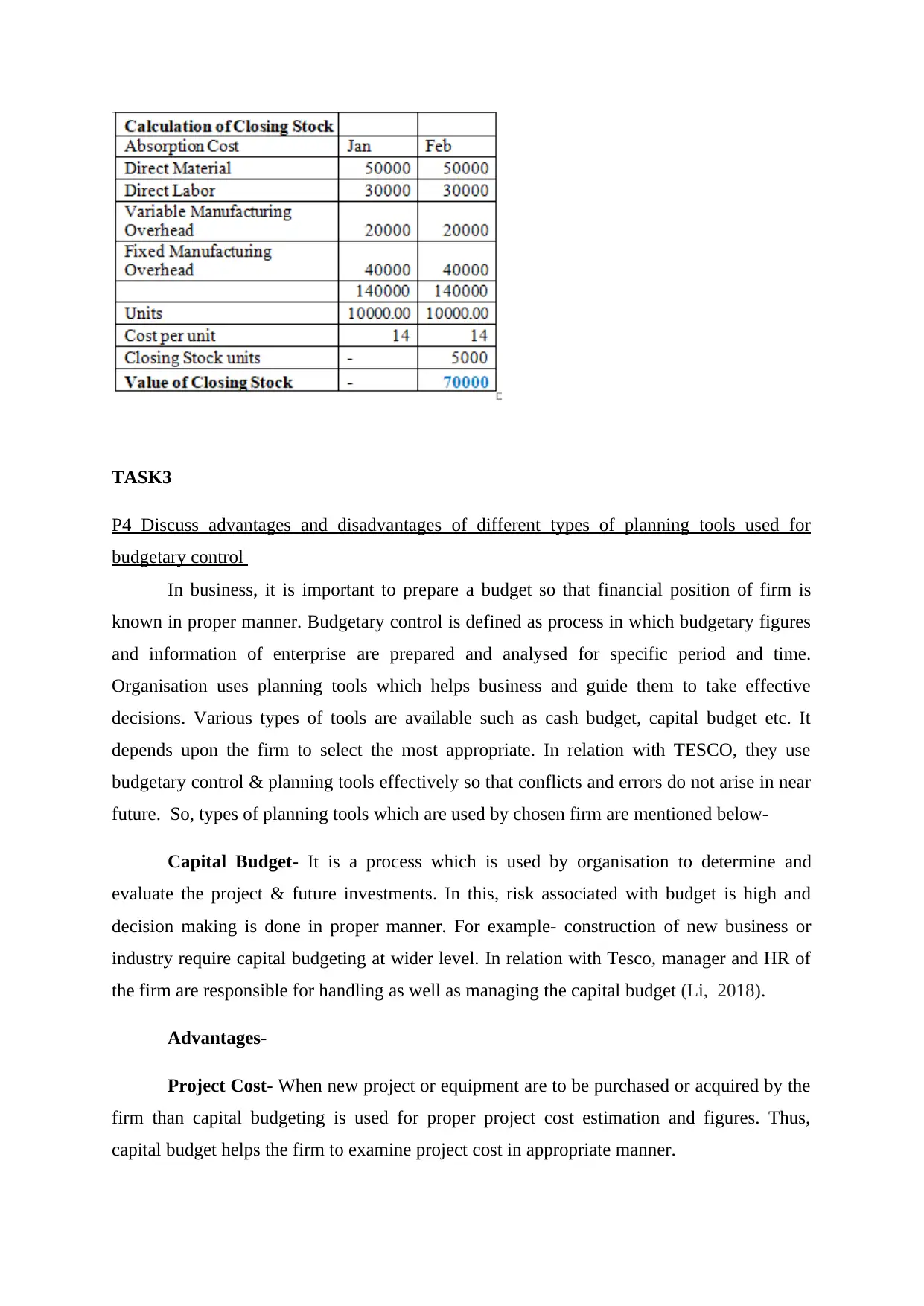
TASK3
P4 Discuss advantages and disadvantages of different types of planning tools used for
budgetary control
In business, it is important to prepare a budget so that financial position of firm is
known in proper manner. Budgetary control is defined as process in which budgetary figures
and information of enterprise are prepared and analysed for specific period and time.
Organisation uses planning tools which helps business and guide them to take effective
decisions. Various types of tools are available such as cash budget, capital budget etc. It
depends upon the firm to select the most appropriate. In relation with TESCO, they use
budgetary control & planning tools effectively so that conflicts and errors do not arise in near
future. So, types of planning tools which are used by chosen firm are mentioned below-
Capital Budget- It is a process which is used by organisation to determine and
evaluate the project & future investments. In this, risk associated with budget is high and
decision making is done in proper manner. For example- construction of new business or
industry require capital budgeting at wider level. In relation with Tesco, manager and HR of
the firm are responsible for handling as well as managing the capital budget (Li, 2018).
Advantages-
Project Cost- When new project or equipment are to be purchased or acquired by the
firm than capital budgeting is used for proper project cost estimation and figures. Thus,
capital budget helps the firm to examine project cost in appropriate manner.
P4 Discuss advantages and disadvantages of different types of planning tools used for
budgetary control
In business, it is important to prepare a budget so that financial position of firm is
known in proper manner. Budgetary control is defined as process in which budgetary figures
and information of enterprise are prepared and analysed for specific period and time.
Organisation uses planning tools which helps business and guide them to take effective
decisions. Various types of tools are available such as cash budget, capital budget etc. It
depends upon the firm to select the most appropriate. In relation with TESCO, they use
budgetary control & planning tools effectively so that conflicts and errors do not arise in near
future. So, types of planning tools which are used by chosen firm are mentioned below-
Capital Budget- It is a process which is used by organisation to determine and
evaluate the project & future investments. In this, risk associated with budget is high and
decision making is done in proper manner. For example- construction of new business or
industry require capital budgeting at wider level. In relation with Tesco, manager and HR of
the firm are responsible for handling as well as managing the capital budget (Li, 2018).
Advantages-
Project Cost- When new project or equipment are to be purchased or acquired by the
firm than capital budgeting is used for proper project cost estimation and figures. Thus,
capital budget helps the firm to examine project cost in appropriate manner.
Paraphrase This Document
Need a fresh take? Get an instant paraphrase of this document with our AI Paraphraser
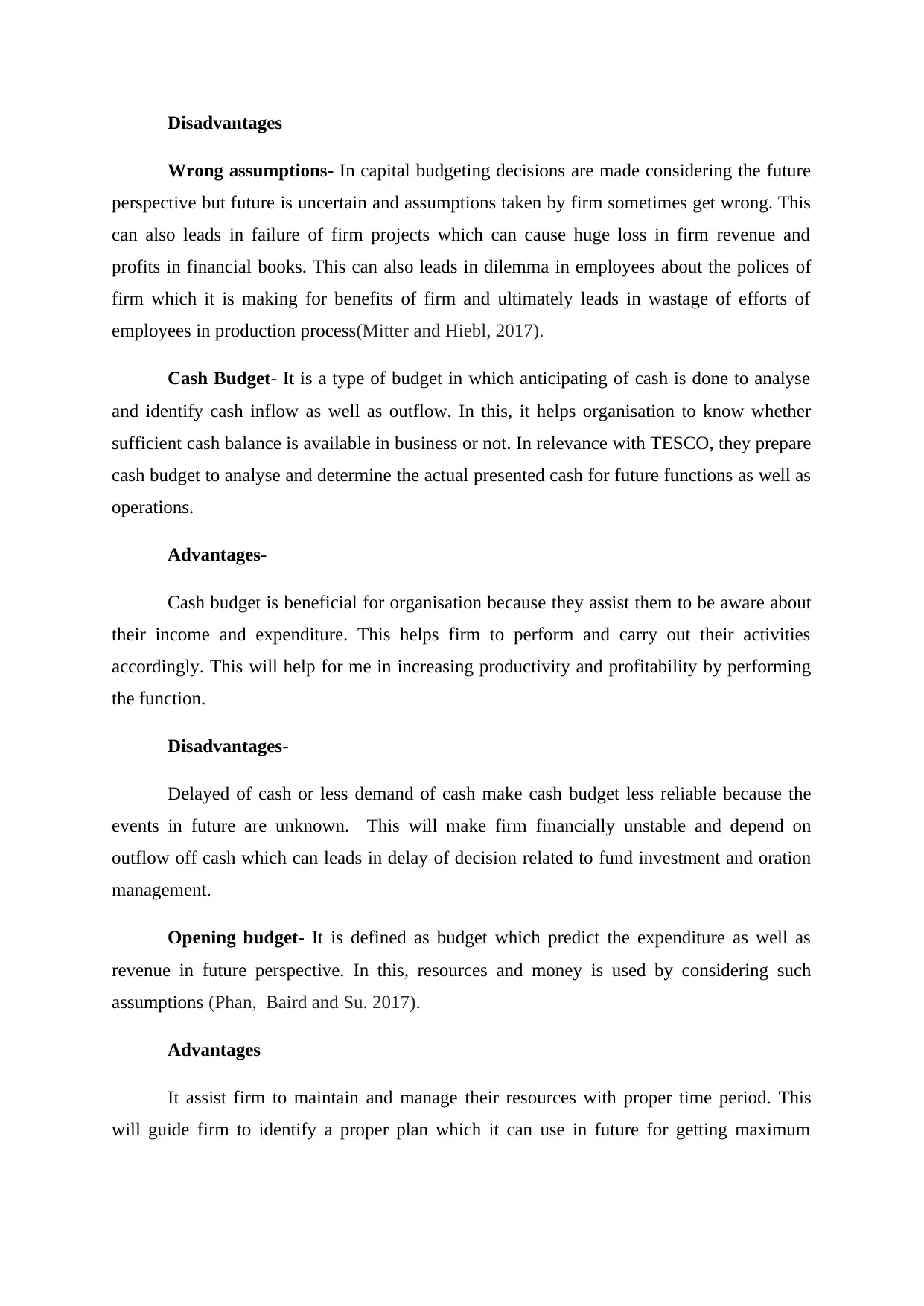
Disadvantages
Wrong assumptions- In capital budgeting decisions are made considering the future
perspective but future is uncertain and assumptions taken by firm sometimes get wrong. This
can also leads in failure of firm projects which can cause huge loss in firm revenue and
profits in financial books. This can also leads in dilemma in employees about the polices of
firm which it is making for benefits of firm and ultimately leads in wastage of efforts of
employees in production process(Mitter and Hiebl, 2017).
Cash Budget- It is a type of budget in which anticipating of cash is done to analyse
and identify cash inflow as well as outflow. In this, it helps organisation to know whether
sufficient cash balance is available in business or not. In relevance with TESCO, they prepare
cash budget to analyse and determine the actual presented cash for future functions as well as
operations.
Advantages-
Cash budget is beneficial for organisation because they assist them to be aware about
their income and expenditure. This helps firm to perform and carry out their activities
accordingly. This will help for me in increasing productivity and profitability by performing
the function.
Disadvantages-
Delayed of cash or less demand of cash make cash budget less reliable because the
events in future are unknown. This will make firm financially unstable and depend on
outflow off cash which can leads in delay of decision related to fund investment and oration
management.
Opening budget- It is defined as budget which predict the expenditure as well as
revenue in future perspective. In this, resources and money is used by considering such
assumptions (Phan, Baird and Su. 2017).
Advantages
It assist firm to maintain and manage their resources with proper time period. This
will guide firm to identify a proper plan which it can use in future for getting maximum
Wrong assumptions- In capital budgeting decisions are made considering the future
perspective but future is uncertain and assumptions taken by firm sometimes get wrong. This
can also leads in failure of firm projects which can cause huge loss in firm revenue and
profits in financial books. This can also leads in dilemma in employees about the polices of
firm which it is making for benefits of firm and ultimately leads in wastage of efforts of
employees in production process(Mitter and Hiebl, 2017).
Cash Budget- It is a type of budget in which anticipating of cash is done to analyse
and identify cash inflow as well as outflow. In this, it helps organisation to know whether
sufficient cash balance is available in business or not. In relevance with TESCO, they prepare
cash budget to analyse and determine the actual presented cash for future functions as well as
operations.
Advantages-
Cash budget is beneficial for organisation because they assist them to be aware about
their income and expenditure. This helps firm to perform and carry out their activities
accordingly. This will help for me in increasing productivity and profitability by performing
the function.
Disadvantages-
Delayed of cash or less demand of cash make cash budget less reliable because the
events in future are unknown. This will make firm financially unstable and depend on
outflow off cash which can leads in delay of decision related to fund investment and oration
management.
Opening budget- It is defined as budget which predict the expenditure as well as
revenue in future perspective. In this, resources and money is used by considering such
assumptions (Phan, Baird and Su. 2017).
Advantages
It assist firm to maintain and manage their resources with proper time period. This
will guide firm to identify a proper plan which it can use in future for getting maximum
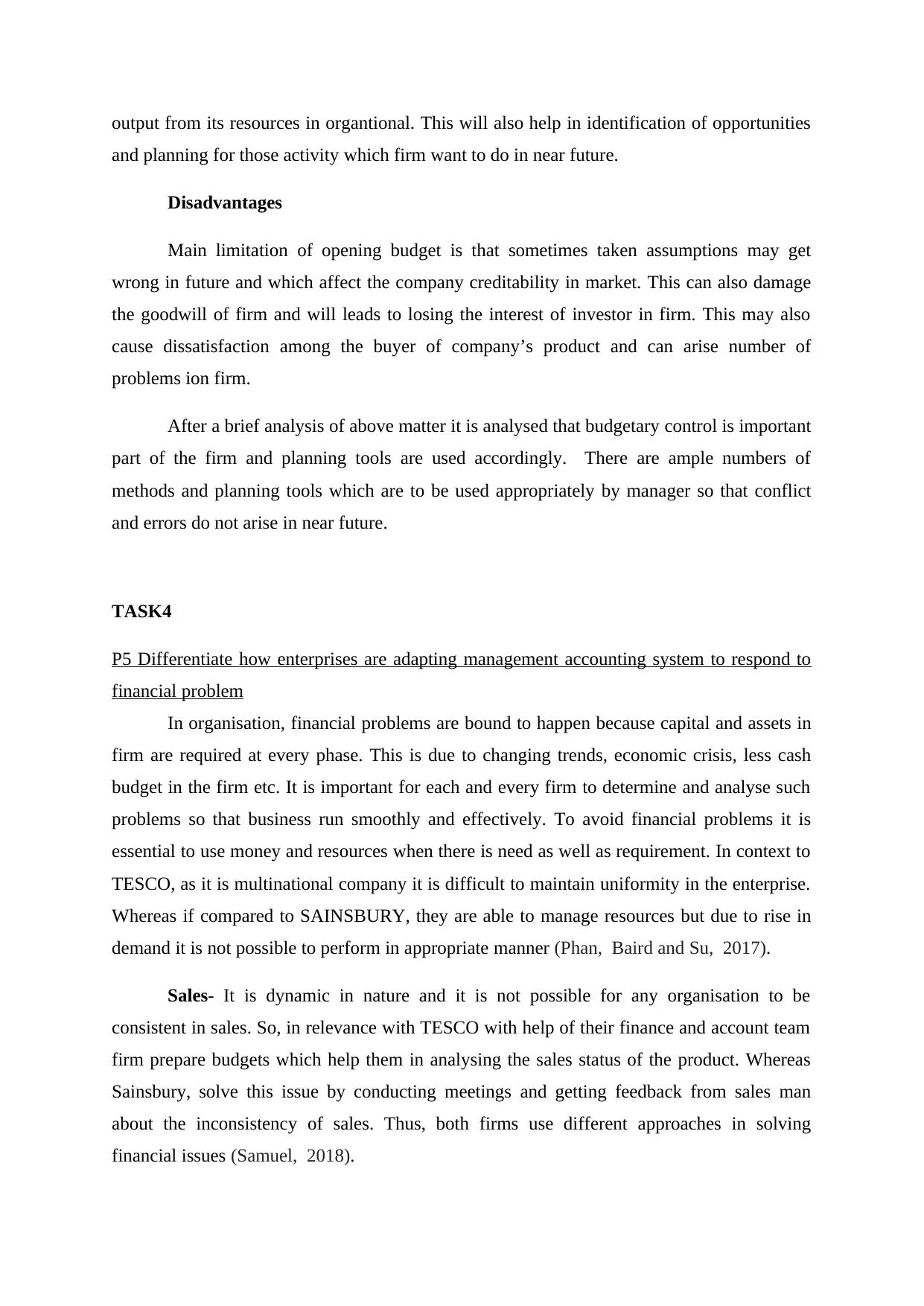
output from its resources in organtional. This will also help in identification of opportunities
and planning for those activity which firm want to do in near future.
Disadvantages
Main limitation of opening budget is that sometimes taken assumptions may get
wrong in future and which affect the company creditability in market. This can also damage
the goodwill of firm and will leads to losing the interest of investor in firm. This may also
cause dissatisfaction among the buyer of company’s product and can arise number of
problems ion firm.
After a brief analysis of above matter it is analysed that budgetary control is important
part of the firm and planning tools are used accordingly. There are ample numbers of
methods and planning tools which are to be used appropriately by manager so that conflict
and errors do not arise in near future.
TASK4
P5 Differentiate how enterprises are adapting management accounting system to respond to
financial problem
In organisation, financial problems are bound to happen because capital and assets in
firm are required at every phase. This is due to changing trends, economic crisis, less cash
budget in the firm etc. It is important for each and every firm to determine and analyse such
problems so that business run smoothly and effectively. To avoid financial problems it is
essential to use money and resources when there is need as well as requirement. In context to
TESCO, as it is multinational company it is difficult to maintain uniformity in the enterprise.
Whereas if compared to SAINSBURY, they are able to manage resources but due to rise in
demand it is not possible to perform in appropriate manner (Phan, Baird and Su, 2017).
Sales- It is dynamic in nature and it is not possible for any organisation to be
consistent in sales. So, in relevance with TESCO with help of their finance and account team
firm prepare budgets which help them in analysing the sales status of the product. Whereas
Sainsbury, solve this issue by conducting meetings and getting feedback from sales man
about the inconsistency of sales. Thus, both firms use different approaches in solving
financial issues (Samuel, 2018).
and planning for those activity which firm want to do in near future.
Disadvantages
Main limitation of opening budget is that sometimes taken assumptions may get
wrong in future and which affect the company creditability in market. This can also damage
the goodwill of firm and will leads to losing the interest of investor in firm. This may also
cause dissatisfaction among the buyer of company’s product and can arise number of
problems ion firm.
After a brief analysis of above matter it is analysed that budgetary control is important
part of the firm and planning tools are used accordingly. There are ample numbers of
methods and planning tools which are to be used appropriately by manager so that conflict
and errors do not arise in near future.
TASK4
P5 Differentiate how enterprises are adapting management accounting system to respond to
financial problem
In organisation, financial problems are bound to happen because capital and assets in
firm are required at every phase. This is due to changing trends, economic crisis, less cash
budget in the firm etc. It is important for each and every firm to determine and analyse such
problems so that business run smoothly and effectively. To avoid financial problems it is
essential to use money and resources when there is need as well as requirement. In context to
TESCO, as it is multinational company it is difficult to maintain uniformity in the enterprise.
Whereas if compared to SAINSBURY, they are able to manage resources but due to rise in
demand it is not possible to perform in appropriate manner (Phan, Baird and Su, 2017).
Sales- It is dynamic in nature and it is not possible for any organisation to be
consistent in sales. So, in relevance with TESCO with help of their finance and account team
firm prepare budgets which help them in analysing the sales status of the product. Whereas
Sainsbury, solve this issue by conducting meetings and getting feedback from sales man
about the inconsistency of sales. Thus, both firms use different approaches in solving
financial issues (Samuel, 2018).
⊘ This is a preview!⊘
Do you want full access?
Subscribe today to unlock all pages.

Trusted by 1+ million students worldwide
1 out of 16
Related Documents
Your All-in-One AI-Powered Toolkit for Academic Success.
+13062052269
info@desklib.com
Available 24*7 on WhatsApp / Email
![[object Object]](/_next/static/media/star-bottom.7253800d.svg)
Unlock your academic potential
Copyright © 2020–2025 A2Z Services. All Rights Reserved. Developed and managed by ZUCOL.





